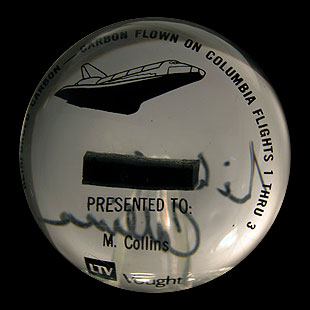
The primary objective for the first three missions of the Space Shuttle Columbia (STS-1 in April 1981, STS-2 in November 1981, and STS-3 in March 1982) was the safe launch and return of the orbiter and crews. The shuttle, as the world's first reusable manned spacecraft, relied on materials that needed to be tested and yet at the same time had to protect the vehicle during flight and reentry.
One such material, reinforced carbon-carbon (RCC) was originally developed by the LTV Corporation for use by the USAF Dyna-Soar space plane project. The RCC would provide protection above 2,700° F, yet it would keep the aluminum structure of the orbiter comfortably below its 350° maximum. RCC was installed on the wing leading edges; the nose cap, including an area immediately aft of the nose on the lower surface (chine panel); and the immediate area around the forward orbiter/external tank attachment.
This acrylic-encased sample of reinforced carbon-carbon material was flown on Columbia missions STS-1 through STS-3. It was presented by LTV Corp. (Vought) to Gemini and Apollo astronaut Michael Collins, who served as Vice President of the company at the time of the flights.
Collins autographed the reverse before parting with the acrylic from his personal collection.
The RCC leading edge of Columbia's left wing was the major focus of the accident investigation following the loss of the orbiter in February 2003. It was later determined that foam shed from the External Tank during launch impacted the number 8 RCC panel creating a breach that during reentry allowed superheated air to penetrate through the wing and melt its aluminum support structure. As a result, increasing aerodynamic forces lead to a loss of control and the break-up of the orbiter.

© 2020 collectSPACE.com All rights reserved.
Questions? E-mail [email protected]

|